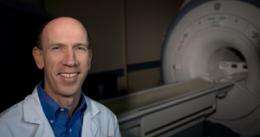Study presents new evidence of how physical activity benefits heart health in seniors

(Medical Xpress) -- Scientists at the Stanford University School of Medicine have found the strongest evidence to date that staying physically active helps improve the functioning of heart arteries in older Americans. The findings, published online June 13 in the Journal of the American College of Cardiology: Cardiovascular Imaging, support the heart-health benefits of even moderate exercise, such as walking one hour per day.
In the study, scientists directly measured the improved ability of heart artery dilation — a measurement of artery health — in more-active older patients. Previous studies have shown the same benefits among male athletes, such as ultra-marathon runners, but this new study was unique in looking at both men and women between the ages of 60 and 72 doing typical physical activities. The benefits were found equally in both genders.
“My patients ask me, ‘How do we really know that exercise is benefiting my heart arteries?’” said senior author Michael McConnell, MD, associate professor of cardiovascular medicine and director of the Preventive Cardiology Clinic at Stanford. “Now we can say that we’ve looked directly at their arteries and shown that the more physically active subjects, even in their 60s, see measurable benefits.”
Scientists compared the healthiness of heart arteries in older adults with their physical activity levels in a group of 212 older patients with no history of heart disease. The patients had been part of the Stanford/Kaiser ADVANCE study of heart disease. (ADVANCE is a large epidemiological study of coronary artery disease that started in 2000 as a collaborative effort between researchers at Stanford University and Kaiser Permanente of Northern California with the overarching goal ofimproving the ability to prevent, diagnose and treat heart disease.)
They found a significant positive correlation between coronary vasodilatation and physical activity. The subjects with moderate activity levels, equivalent to one hour of walking a day, dilated their coronary arteries almost 50 percent more than subjects with lower activity levels. These findings remained significant even after adjustment for cardiac risk factors, coronary calcium score and the use of heart medications such as statins.
“If you exercise more, your vessels dilate more,” McConnell said. “The more a vessel dilates, the healthier the vessel. Those who don’t do anything beyond light activity have by far the lowest dilation levels. Those who include high-level activities, like singles tennis or swimming, at least once a week dilated their heart arteries twice as much.”
To measure the dilating capacity of heart vessels, scientists used noninvasive, high-resolution magnetic resonance imaging of the coronary arteries, a technique developed at Stanford. An MRI coronary angiogram was conducted both before and after administering a nitroglycerin pill under the tongue with a five-minute wait between the two angiograms. The change in size of the coronary artery was then measured.
The physical activity levels of the subjects were measured using the Stanford Seven-Day Physical Activity Recall Questionnaire, which was developed at Stanford in the 1980s and has been used in many epidemiologic studies. The interview-administered survey asked subjects to estimate energy levels recalling typical weekly activities: mopping or a brisk walk equaled moderate activity levels; construction work or doubles tennis equaled intense levels; chopping wood or running equaled very intense levels.
Previous studies have shown that athletes have a greater coronary vasodilatory response to nitroglycerin, which gets converted to nitric oxide, compared with people who are not physically active. Nitric oxide is the main chemical that the walls of the heart arteries produce to tell the vessels to dilate.
“By imaging after giving nitroglycerin, we could measure the coronary artery response to nitric oxide, and found that inactive people are less responsive than active people,” said Patricia Nguyen, MD, an instructor in cardiovascular medicine and first author of the study.
According to the American Heart Association, nearly 70 percent of Americans don’t get enough physical activity. It recommends at least 30 minutes of moderate physical activity, like brisk walking, at least five times a week to lower the risks of heart disease, stroke and diabetes. Children need 60 minutes every day.














